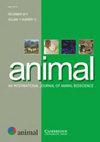Novel pathways linked to the expression of temperament in Merino sheep: a genome-wide association study
IF 4
2区 农林科学
Q1 AGRICULTURE, DAIRY & ANIMAL SCIENCE
引用次数: 0
Abstract
Animal temperament refers to the inherent behavioural and emotional characteristics of an animal, influencing how it interacts with its environment. The selection of sheep for temperament can change the temperament traits of the selected line and improve the welfare and production (reproduction, growth, immunity) of those animals. To understand the genetics that underly variation in temperament in sheep, and how selection on temperament can affect other production traits, a genome-wide association study was carried out. Merino sheep from lines selected for traits of calm and nervous temperament, and a commercial population, on which the temperament traits had never been assessed, were used. Blood samples from the three populations were genotyped using an Illumina GGP Ovine 50 K Genotyping BeadChip. The calm and nervous populations in the selected lines presented as distinct genetic populations, and 2 729 of the 45 761 single nucleotide polymorphisms (SNPs) had significantly different proportions between the two lines. Of those 2 729 SNPs, 2 084 were also associated with temperament traits in the commercial population. A genomic annotation identified 81 candidate genes for temperament, nearly half of which are associated with disorders of social behaviour in humans. Five of those 81 candidate genes are related to production traits in sheep. Two genes were associated with personality disorders in humans and with production traits in sheep. We identified significant enrichment in genes involved in nervous system processes such as the regulation of systemic arterial blood pressure, ventricular myocyte action, multicellular organismal signalling, ion transmembrane transport, and calcium ion binding, suggesting that temperament is underpinned by variation in multiple biological systems. Our results contribute to understanding of the genetic basis of animal temperament which could be applied to the genetic evaluation of temperament in sheep and other farm animals.
与美利奴羊性情表达有关的新途径:全基因组关联研究
动物性情是指动物固有的行为和情感特征,影响着动物与环境的互动方式。对绵羊进行性情选择可以改变所选品系的性情特征,并改善这些动物的福利和生产状况(繁殖、生长、免疫)。为了了解绵羊性情变异的遗传学基础,以及性情选择如何影响其他生产性状,我们开展了一项全基因组关联研究。该研究使用了针对绵羊沉稳和神经质性情特征选择的美利奴羊品系,以及一个从未对其性情特征进行过评估的商业种群。使用 Illumina GGP Ovine 50 K 基因分型 BeadChip 对这三个群体的血液样本进行了基因分型。在所选品系中,沉着和紧张的群体表现为不同的遗传群体,在 45 761 个单核苷酸多态性()中,有 2 729 个在两个品系中的比例有显著差异。在这 2 729 个 SNPs 中,有 2 084 个也与商业种群的性情特征相关。基因组注释确定了 81 个性情候选基因,其中近一半与人类的社会行为障碍有关。这 81 个候选基因中有 5 个与绵羊的生产性状有关。有两个基因与人类的人格障碍和绵羊的生产性状有关。我们发现涉及神经系统过程的基因明显丰富,如全身动脉血压调节、心室肌细胞作用、多细胞生物体信号传导、离子跨膜转运和钙离子结合等,这表明性情是由多个生物系统的变异支撑的。我们的研究结果有助于了解动物性情的遗传基础,可用于绵羊和其他农场动物性情的遗传评估。
本文章由计算机程序翻译,如有差异,请以英文原文为准。
求助全文
约1分钟内获得全文
求助全文
来源期刊

Animal
农林科学-奶制品与动物科学
CiteScore
7.50
自引率
2.80%
发文量
246
审稿时长
3 months
期刊介绍:
Editorial board
animal attracts the best research in animal biology and animal systems from across the spectrum of the agricultural, biomedical, and environmental sciences. It is the central element in an exciting collaboration between the British Society of Animal Science (BSAS), Institut National de la Recherche Agronomique (INRA) and the European Federation of Animal Science (EAAP) and represents a merging of three scientific journals: Animal Science; Animal Research; Reproduction, Nutrition, Development. animal publishes original cutting-edge research, ''hot'' topics and horizon-scanning reviews on animal-related aspects of the life sciences at the molecular, cellular, organ, whole animal and production system levels. The main subject areas include: breeding and genetics; nutrition; physiology and functional biology of systems; behaviour, health and welfare; farming systems, environmental impact and climate change; product quality, human health and well-being. Animal models and papers dealing with the integration of research between these topics and their impact on the environment and people are particularly welcome.
 求助内容:
求助内容: 应助结果提醒方式:
应助结果提醒方式:


